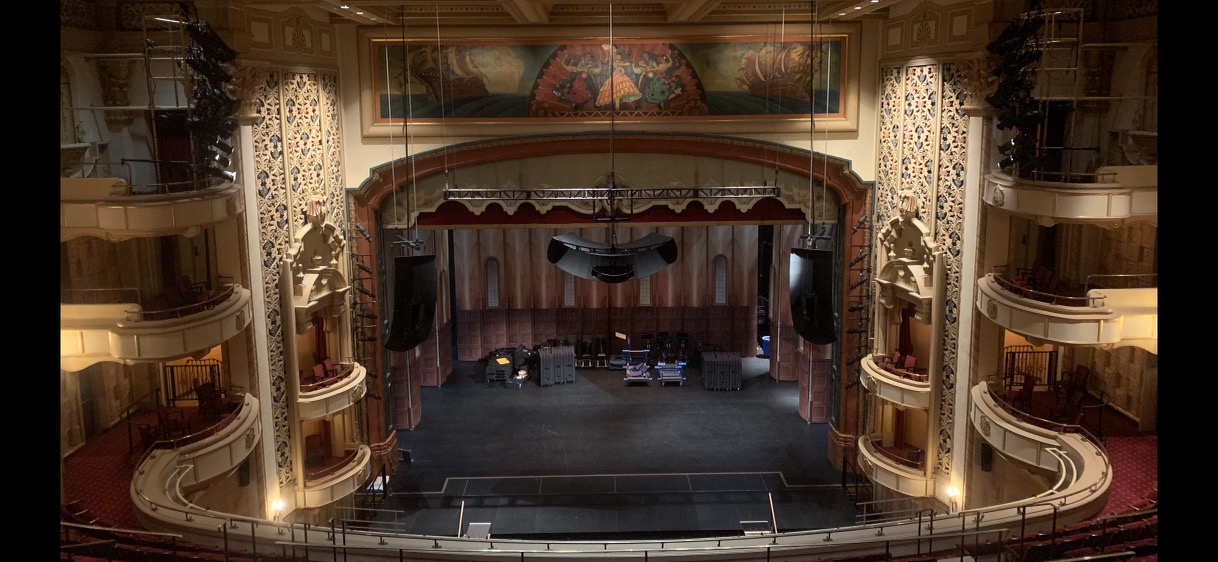In 2008, the Santa Barbara Center for the Performing Arts (SBCPA) completed a historic renovation of a classic 95-year-old, 1,500 seat venue: The Granada Theater. The venue, which Ocean Way Audio founder and legendary record producer Allen Sides refers to as 'one of the greatest venues in California', made significant renovations to its stage, as well as lighting, rigging and artist facilities. In September, the venue—which serves eight resident companies and hosts a diverse range of performances throughout the year—unveiled a new point source sound system from Burbank, CA-based Ocean Way Audio.
The new system is able to distribute 90 degrees of audio in both the horizontal and vertical directions, something not possible with the use of a traditional line array. It is also able to deliver a direct, high-quality stereo signal to every seat in the house with minimal boundary reflections.
"This is undoubtedly one of the greatest venues in California," said Allen Sides, founder and CEO of Ocean Way Audio. "With this audio system, we believe we have created something here that is unique and sets this theater apart from other venues of similar size."
[The Hybrid Workplace: Trends in Acoustics and Audio]
Aside from achieving a full-bandwidth response that is capable of delivering an even, stereo response throughout the venue, the new system is extremely versatile and able to handle a variety of performances across many genres: "You could have the London Symphony followed by Brian Setzer," said Sides. "Getting the acoustics right for these two types of performances is not an easy task."
Point Source vs. Line Array
"When Allen came in, he said, ‘What you need is more of a point source—the speakers you are using are fighting with each other and the engineer can’t hear what is happening or trust what he is hearing,'" said David Johnson, vice president of operations and production, Granada Theatre. "While line array speakers are prevalent today, this set up would not work for us. With traditional line arrays, there was uneven sound dispersion all around the theater and each of our patrons was having a different (stereo) experience. Allen’s idea was to create a system that could deliver sound from a single source, both wide and high, so everyone in every seat can hear both speakers at once."
Rather than opting for an "off the shelf" traditional line array, Granada collaborated with Ocean Way Audio on implementing a bespoke single point design. The new Ocean Way Audio point source speaker system replaced a traditional split stack line array system that was adequate, but ultimately wasn't able to deliver a pristine stereo signal to every seat in the house.
"Allen explained how line arrays have narrow and uneven coverage," Johnson added. "For instance, if you sit in the middle, you can hear both the left and right speakers but not on the sides."
[The Power of Immersive Audio]
"In a very live venue, the more sources you have of sound that hit and create reflections from side walls, the less clear and less defined the sound is," Sides explained. "And if there are many reflections in a room, it can reduce resolution and definition, even with dialog. Our system is a point-source, constant-directivity system. So instead of being split into four separate pieces, it is a single system that sits in ideal positions. This eliminates tons of reflections from the four sources—you only get one set of reflections from the point source."
The AeroWave system also features complete directivity-control to 100 Hz, so low frequency information goes out directly into the auditorium rather than creating first, second or third wave reflections. The net result is elimination of most unwanted reflections and a clear, more defined sound.
Even Sound Dispersion
Granada engineer Jon Fowler was among the first to see the new AeroWave system being implemented and tested. " We are the first theater in the world to use this system, and when it came in the building it didn’t look like anything I’ve seen before, and I have been doing live sound and recording for 15 years," he recalled.
Now that the new system is up and running, it has made Fowler's job easier. "I’ve been working on the old PA for about eight years now," he said. "But with the new AeroWave system, it's almost like I don’t have to do a lot of EQ work like I did before. You pretty much just pull up the faders and it already sounds good."
The AeroWave system is roughly 10 dB more efficient than any conventional line array because of its incredibly efficient straight horn design, which means it takes only a third of the power to reach the same volume. This equates to lower distortion and a more natural sound even at high sound pressure levels.
[Music Festivals Are Back. Are You Prepared to Deal with the New Normal?}
Fowler said the new system has achieved the goal of creating even sound dispersion throughout the venue: "Now, you can move around the room and hear great stereo imaging whether you are right in front, extreme right or left, or anywhere in between—it is really incredible."
The system was put to the test at a private Grand Opening event for invited guests on Sept. 23 and then again for two public performances of the new Mariachi opera by Opera Santa Barbara and Kostis Protopapas in early October. "We had glowing reviews at the end of the show," Fowler recalled. "A lot of people were coming up to front of house and saying things like, 'It's so nice to hear a show with perfect sound.' It is reassuring to know that I can trust what I am hearing at front of house and know that it is going to translate well throughout the entire hall!"
